Dreadlocks have evolved from their spiritual and cultural roots into one of the most versatile and expressive hairstyles for modern men.
Whether you’re seeking a complete transformation or simply want to add edge to your current look, dreadlocks offer endless possibilities for personal expression and style innovation.
The beauty of this hairstyle lies in its adaptability—from professional settings to creative industries, there’s a dreadlock style that fits every lifestyle and personality.
This comprehensive guide explores 33 Latest Dreadlock Styles for Men That Are Bold and Modern, showcasing everything from classic locks to contemporary twists that push the boundaries of hair artistry.
You’ll discover maintenance tips, styling techniques, and inspiration for choosing the perfect dreadlock variation that matches your face shape, hair texture, and personal aesthetic.
Get ready to explore a world where tradition meets innovation, and where your hair becomes a powerful statement of individuality.
Contents
- 1 1. High Top Fade Dreads
- 2 2. Free Form Dreadlocks
- 3 3. Two-Strand Twist Dreads
- 4 4. Dread Mohawk
- 5 5. Shoulder-Length Dreads
- 6 6. Short Starter Dreads
- 7 7. Colored Dreads
- 8 8. Undercut Dreads
- 9 9. Long Flowing Dreads
- 10 10. Dread Bun (Man Bun with Dreads)
- 11 11. Thin Dreads (Pencil Dreads)
- 12 12. Thick Dreads (Chunky Dreads)
- 13 13. Dread Ponytail
- 14 14. Dread Braids
- 15 15. Side-Swept Dreads
- 16 16. Dread Top Knot
- 17 17. Triangle-Parted Dreads
- 18 18. Blonde Dreads
- 19 19. Twisted Dreads with Design
- 20 20. Dread with Taper Fade
- 21 21. Dreadlock Frohawk
- 22 22. Burgundy Dreads
- 23 23. Gray/Silver Dreads
- 24 24. Red Dreads
- 25 25. Blue Dreads
- 26 26. Ombre Dreads
- 27 27. Half-Up Dread Style
- 28 28. Dread Pigtails
- 29 29. Messy Dread Bun
- 30 30. Sisterlocks for Men
- 31 31. Freeform with Undercut
- 32 32. Dread Wrapped with Thread
- 33 33. Crown Braid Dreads
- 34 Maintenance Tips for Modern Dreadlocks
- 35 Dreadlock Products and Tools Essential for Men
- 36 Common Dreadlock Mistakes to Avoid
- 37 How Long Does It Take to Grow Dreadlocks?
- 38 Dreadlocks in Professional Settings
- 39 Cultural Significance and Respect
- 40 Transitioning from Relaxed or Chemically Treated Hair
- 41 Dreadlock Removal and Reversibility
- 42 Seasonal Dreadlock Care Adjustments
- 43 Dreadlocks and Physical Activity
- 44 Styling Dreadlocks for Special Occasions
- 45 Budget Considerations for Dreadlock Maintenance
- 46 Conclusion
1. High Top Fade Dreads

High top fade dreads combine the classic urban fade with vertical dreadlocks on top, creating a striking silhouette that demands attention.
This style has experienced a massive resurgence in recent years, blending 90s nostalgia with modern grooming standards.
- The sides and back are cut extremely short or shaved completely, creating a dramatic contrast with the longer dreads on top
- The dreads stand upright, adding significant height and creating an architecturally impressive shape
- This style works exceptionally well for men with naturally coarse or kinky hair textures
- Maintenance requires regular fade touch-ups every two to three weeks to keep the contrast sharp
- The top dreads can be styled forward, backward, or left natural for different daily looks
- This cut flatters oval and square face shapes by adding vertical dimension
- Popular among athletes and entertainers who want a bold, memorable appearance
2. Free Form Dreadlocks
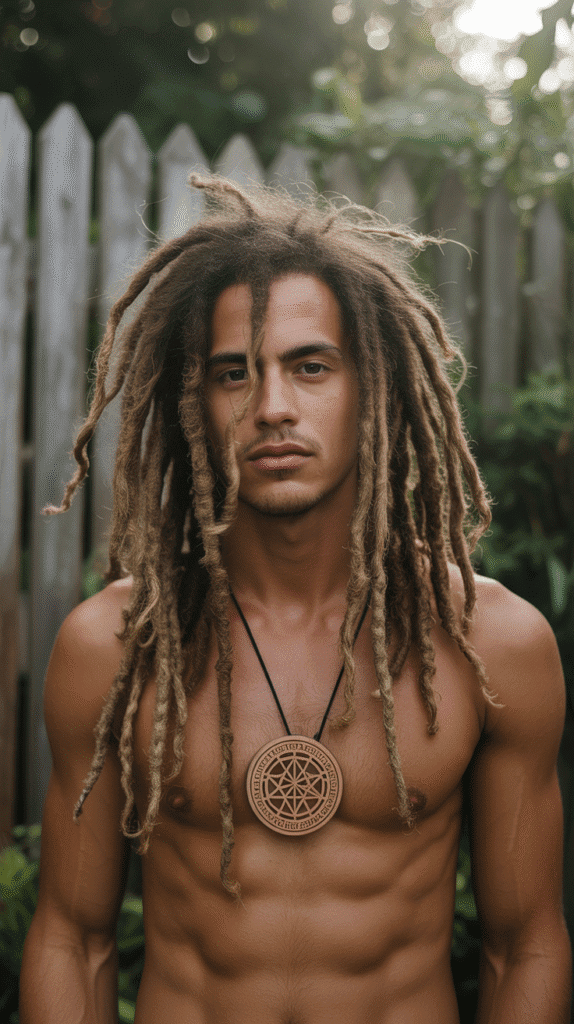
Free form dreadlocks represent the most organic approach to the style, allowing hair to lock naturally without manipulation or forced sectioning.
This method honors the original spiritual essence of dreadlocks while creating a completely unique pattern for each individual.
- Hair is simply washed and allowed to mat and lock on its own over time
- No twisting, backcombing, or systematic sectioning is involved in the formation process
- Each lock develops its own size, shape, and direction based on natural hair growth patterns
- The result is an authentic, individualized look that cannot be replicated
- This method requires patience, as locks can take six months to two years to fully form
- Regular washing with residue-free shampoo supports the locking process without interference
- Free form dreads often appear more textured and less uniform than manicured styles
- This approach resonates with men seeking a more spiritual or philosophical connection to their hair
3. Two-Strand Twist Dreads
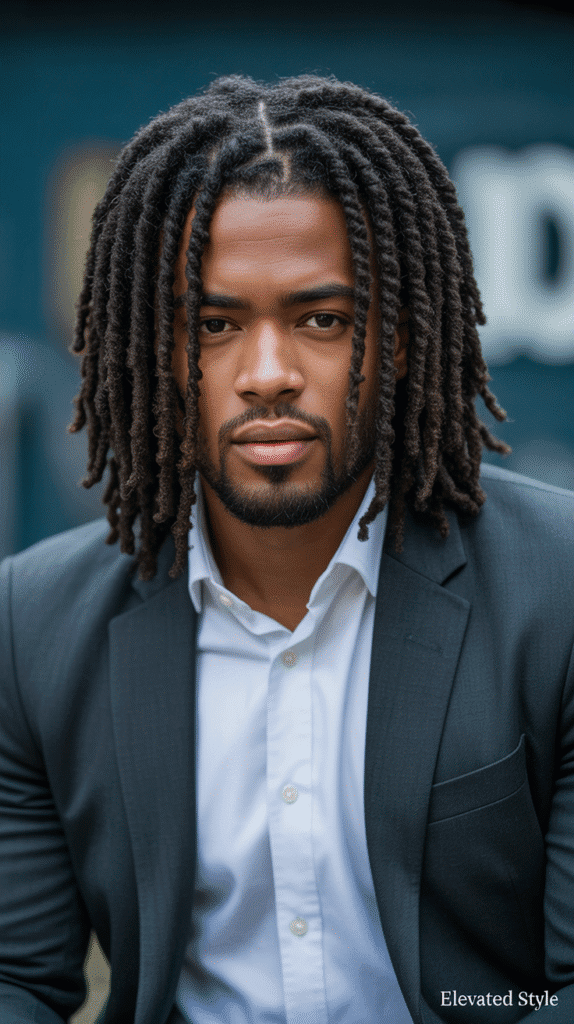
Two-strand twist dreads begin with the traditional twisting technique that eventually locks into permanent dreadlocks over time.
This starter method provides a neat, defined look from the very beginning while transitioning into mature locks.
- Two sections of hair are twisted around each other in a rope-like pattern
- The twisting creates immediate definition and uniform size across all locks
- This technique works well for all hair textures, though it’s particularly popular with Type 4 hair
- Maintenance involves re-twisting the roots every four to six weeks as new growth appears
- The twists gradually tighten and lock permanently over several months
- This method allows for more control over lock size and placement compared to free form
- The resulting dreads have a neat, cylindrical appearance with visible twist patterns
- Ideal for professional environments where groomed appearance matters
4. Dread Mohawk
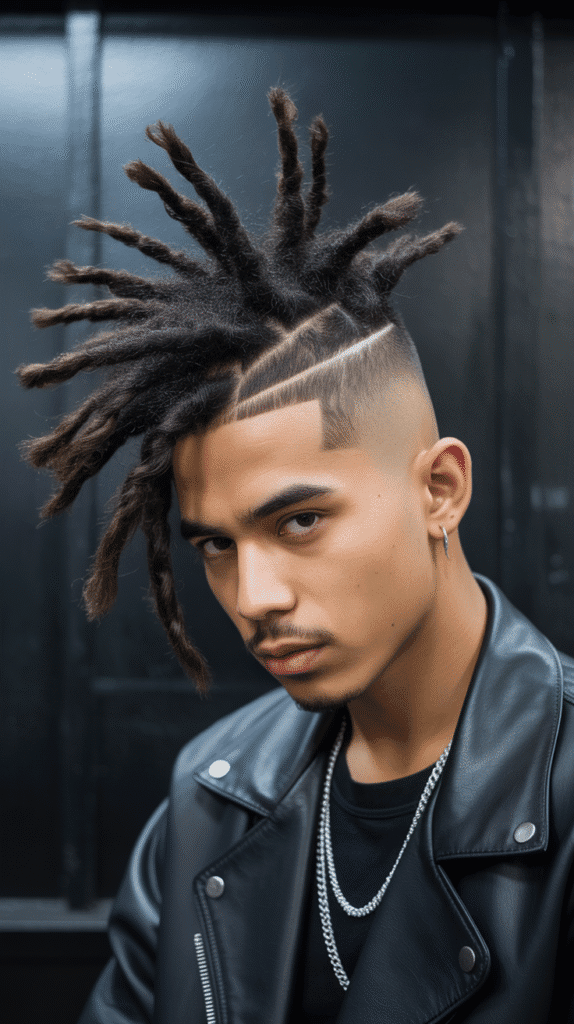
The dread mohawk takes the rebellious punk aesthetic and combines it with the texture and dimension of dreadlocks.
This bold style features shaved or very short sides with a strip of dreads running down the center of the head.
- The mohawk strip can vary in width from narrow (2-3 inches) to wide (4-6 inches)
- Dreads in the mohawk section can be styled upright, fanned out, or laid down
- The contrast between shaved sides and textured center creates maximum visual impact
- This style requires commitment to regular side maintenance to preserve the sharp lines
- Length variations allow for different styling options, from short spikes to long flowing locks
- Color can be added to the dreads for even more dramatic effect
- Works best on men with confident personalities who embrace attention
- The versatility allows transformation from edgy to sophisticated depending on styling
5. Shoulder-Length Dreads
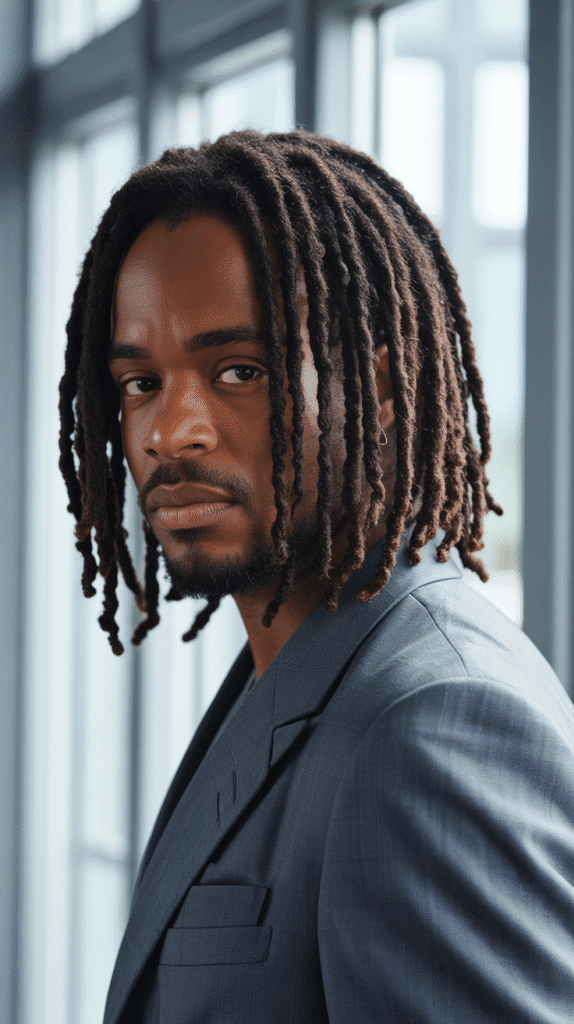
Shoulder-length dreads hit the sweet spot between manageability and versatility, offering numerous styling options while remaining practical for daily life.
This medium length has become increasingly popular among professionals and creatives alike.
- The length typically ranges from chin to shoulder level, approximately 12-16 inches
- Provides enough length to pull back into ponytails, buns, or half-up styles
- Easier to maintain than longer dreads while offering more versatility than short locks
- This length showcases the texture and movement of mature dreadlocks beautifully
- Washing and drying times are reasonable compared to longer lengths
- Professional settings generally accept this length when styled neatly
- The weight is distributed comfortably without causing scalp strain
- Natural shrinkage should be considered when growing to this length
6. Short Starter Dreads
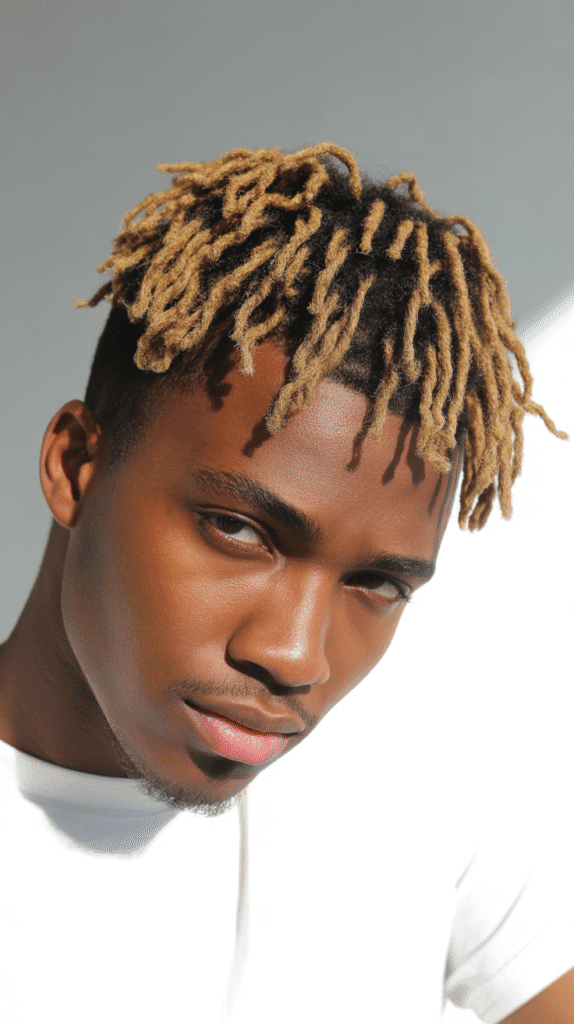
Short starter dreads represent the beginning phase of the dreadlock journey, typically ranging from one to four inches in length.
This stage is perfect for men testing the commitment or preferring a more conservative professional appearance.
- Hair is sectioned and begun using methods like two-strand twists, comb coils, or interlocking
- The short length makes daily maintenance and washing significantly easier
- This stage typically lasts three to six months before locks mature and lengthen
- The neat, budding appearance works well in corporate or formal environments
- Less product is needed during this phase compared to longer dreads
- The scalp is more visible, so cleanliness is especially important
- Short dreads require patience as the locking process establishes
- This length minimizes the awkward teenage phase that longer dreads experience
7. Colored Dreads
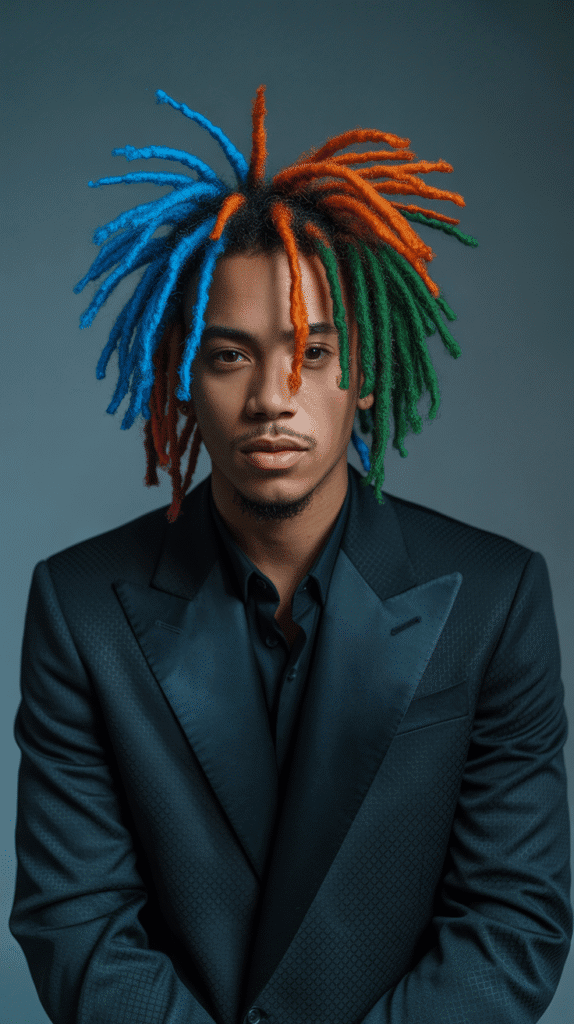
Colored dreads transform traditional locks into vibrant artistic statements, allowing men to express creativity and personality through their hair.
From subtle highlights to bold full-color transformations, the options are limitless.
- Popular colors include platinum blonde, burgundy, grey, blue, red, and multi-tone combinations
- Bleaching is often required before applying lighter or vibrant colors to dark hair
- Color works best on mature dreads that have fully locked and can withstand chemical processing
- Professional coloring is recommended to avoid damage and achieve even color distribution
- Maintenance includes color-safe, sulfate-free shampoos to preserve vibrancy
- Root touch-ups are needed every 4-8 weeks depending on growth rate and color contrast
- Temporary options like hair chalk or washable dyes allow experimentation without commitment
- Colored dreads particularly stand out in creative industries like music, fashion, and digital media
8. Undercut Dreads
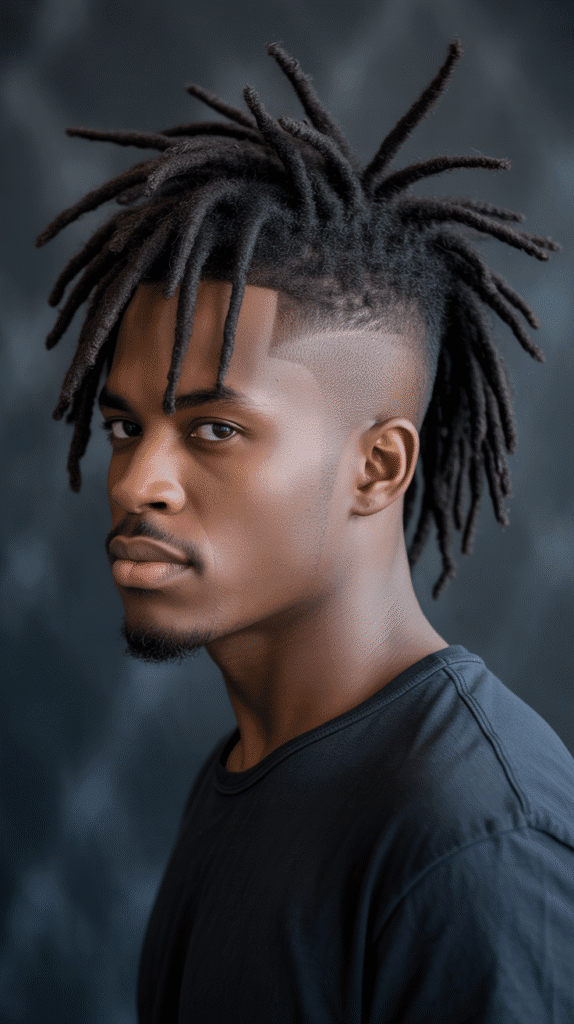
Undercut dreads feature closely shaved or faded sides and back with longer dreadlocks on top, creating a clean modern look with edge and sophistication.
This style has become a favorite among young professionals and creatives.
- The undercut creates a distinct separation between the top dreads and shaved sections
- Top dreads can be any length from short to long, offering styling flexibility
- The contrast emphasizes the texture and movement of the dreads
- Significantly reduces bulk and heat, making it ideal for warmer climates
- Requires regular barber visits every 2-4 weeks to maintain the clean undercut
- Styling options include wearing dreads down, in a top knot, or swept to one side
- This cut flatters most face shapes by creating balance and structure
- Works well with or without facial hair for different aesthetic effects
9. Long Flowing Dreads
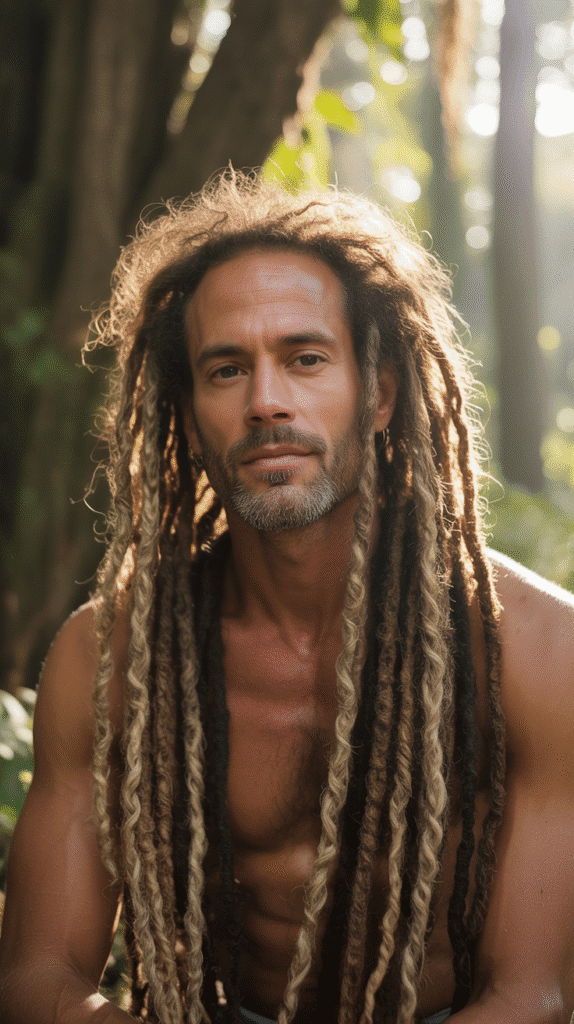
Long flowing dreads that extend past the shoulders create a powerful, majestic appearance that commands respect and attention.
This length represents years of commitment and patience in the dreadlock journey.
- Length typically ranges from mid-back to waist level or beyond
- The weight and movement of long dreads create a distinctive presence
- Requires significant time investment, often taking 3-5+ years to achieve
- Maintenance becomes more time-consuming with washing, drying, and retwisting
- Styling options include braids, buns, ponytails, and decorative wraps
- The dramatic length works exceptionally well for artistic and creative personalities
- Sleeping with a silk or satin bonnet protects long dreads while resting
- Regular palm rolling or interlocking maintains neatness at this length
10. Dread Bun (Man Bun with Dreads)
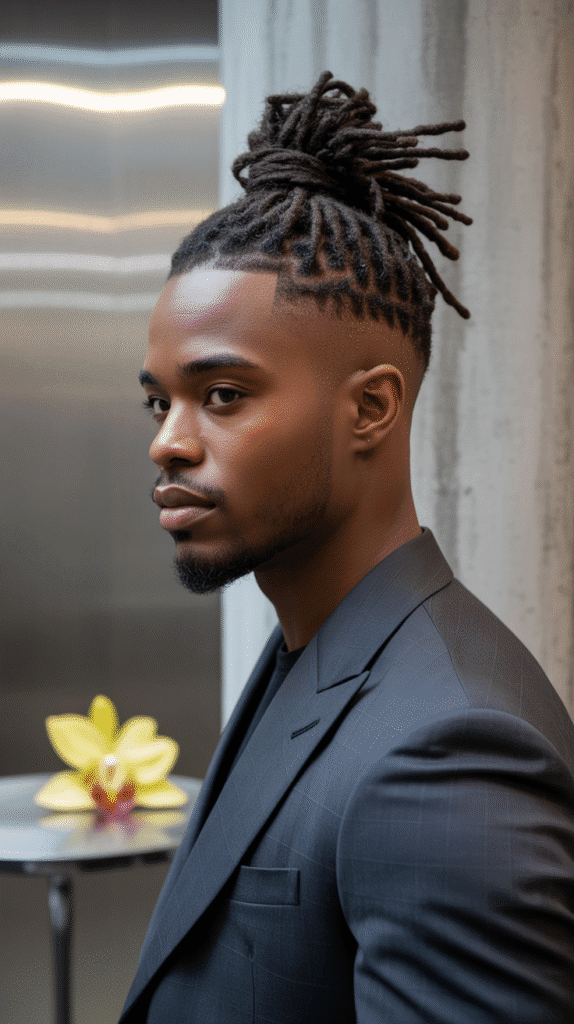
The dread bun combines the popular man bun trend with the unique texture of dreadlocks, creating a practical yet stylish option for medium to long dreads.
This versatile style works for both casual and professional settings.
- All dreads are gathered and secured at the crown or back of the head
- The positioning can be high (top knot), medium (crown), or low (nape)
- Elastic bands designed for dreadlocks prevent slippage and damage
- This style keeps dreads secure during physical activities or work
- The bun showcases the length while maintaining a clean, organized appearance
- Variations include full buns, half-up styles, or twisted bun formations
- Face shape consideration: high buns elongate round faces, low buns balance long faces
- Removing the bun regularly prevents excessive tension on the scalp
11. Thin Dreads (Pencil Dreads)
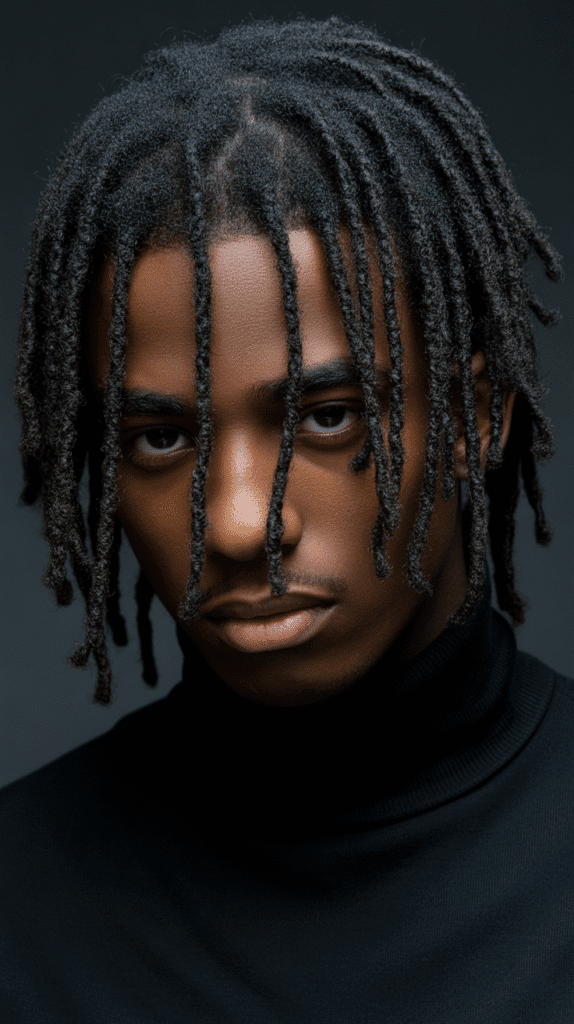
Thin dreads, often called pencil dreads due to their slender diameter, offer a refined and intricate appearance compared to thicker traditional locks.
This style requires precise sectioning and appeals to men seeking a more delicate, detailed look.
- Individual dreads are approximately pencil-width or smaller in diameter
- More locks mean increased installation and maintenance time
- The thinner size creates more movement and flexibility in styling
- This style works beautifully for all hair lengths from short to extra long
- Installation time is significantly longer, often requiring multiple sessions
- Thin dreads lock faster than thicker dreads due to their smaller size
- The delicate appearance contrasts with the bold statement of traditional dreadlocks
- Particularly popular in African and Caribbean dreadlock traditions
12. Thick Dreads (Chunky Dreads)
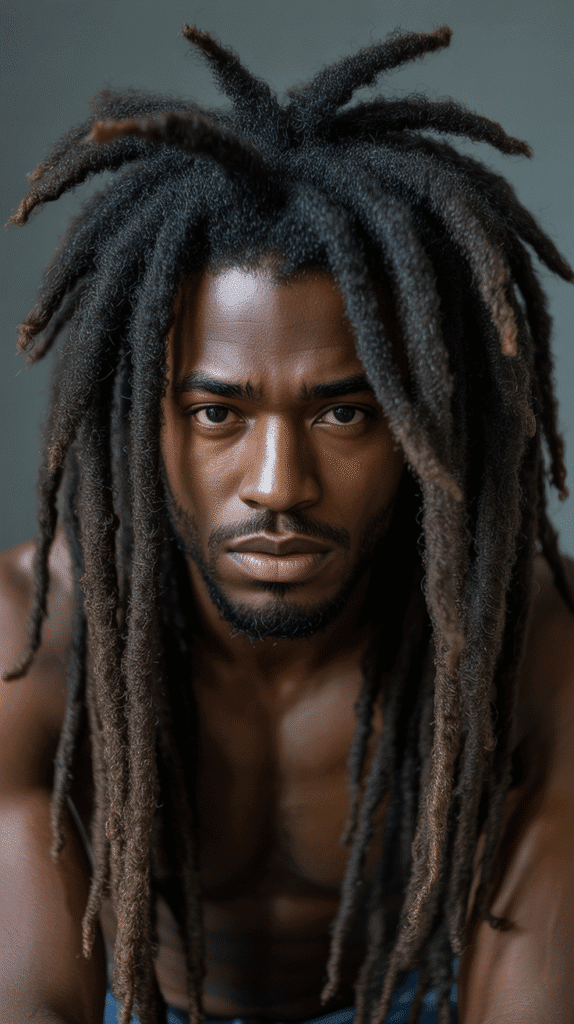
Thick or chunky dreads make a bold, powerful statement with their substantial diameter and impressive presence.
These larger locks create fewer individual dreads with more visual impact per lock.
- Each dread is significantly thicker, often 1-2 inches or more in diameter
- Fewer total locks mean less overall maintenance time
- The substantial size creates a more dramatic, masculine appearance
- Thick dreads take longer to fully mature and lock throughout their diameter
- This style particularly suits men with abundant, dense hair growth
- The weight of thick dreads is more evenly distributed across fewer anchor points
- Styling is somewhat limited compared to thinner dreads due to the bulk
- Creates a strong, primal aesthetic that resonates with many men
13. Dread Ponytail
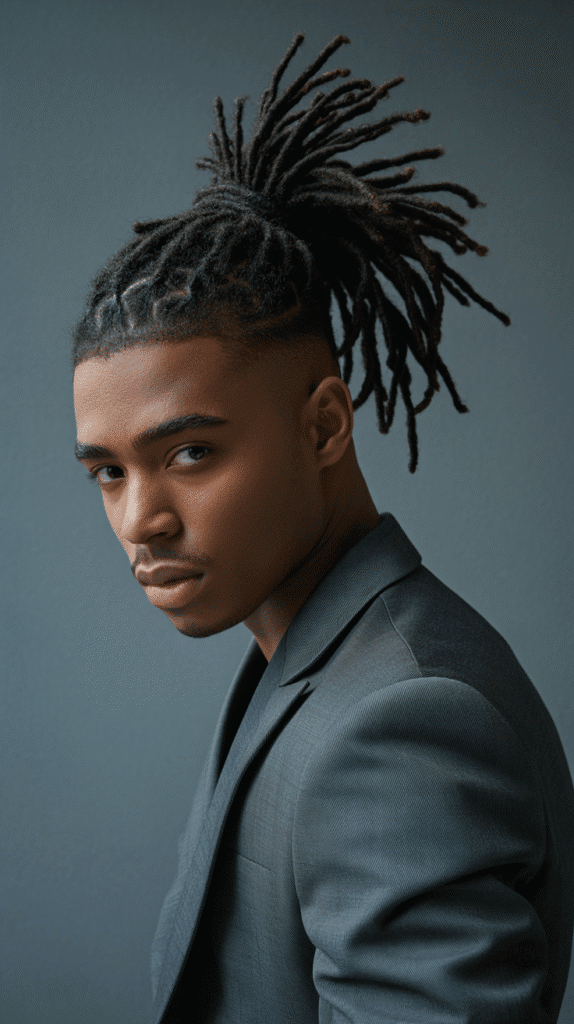
The dread ponytail offers a classic, practical styling option for medium to long dreadlocks, pulling all locks back into a single secured bundle.
This timeless style combines functionality with a polished appearance.
- All dreads are gathered and secured at varying heights on the back of the head
- Low ponytails create a more conservative, professional look
- Mid-level ponytails offer balanced versatility for multiple settings
- High ponytails provide a sporty, active appearance
- Use dreadlock-friendly hair ties or wrapped sections of dread to secure
- This style prevents dreads from interfering with work, sports, or daily activities
- The ponytail can be left straight or styled with additional wraps and accessories
- Alternating ponytail positions prevents stress on specific scalp areas
14. Dread Braids
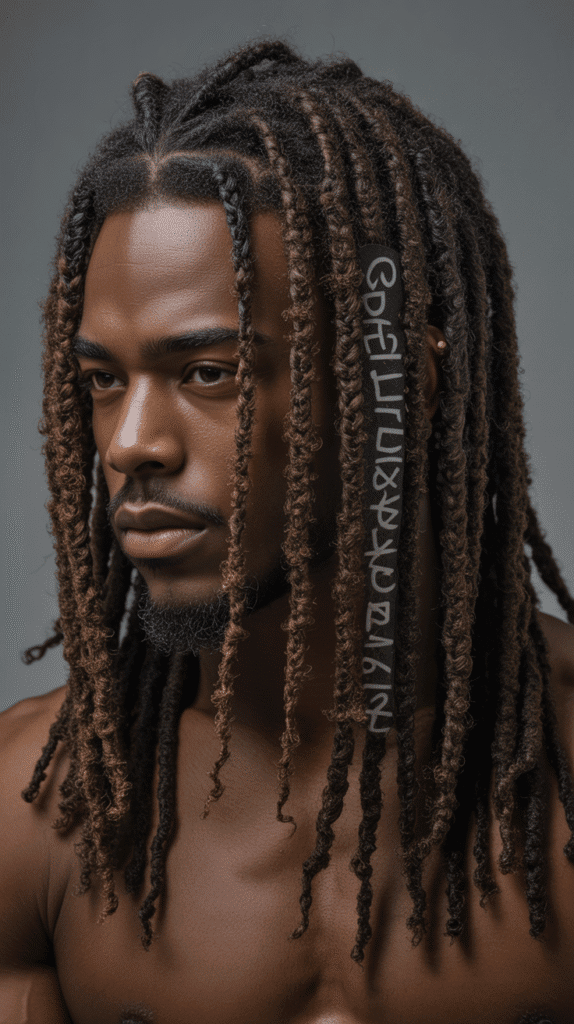
Dread braids involve braiding sections of dreadlocks together, creating intricate patterns and additional texture dimension.
This style showcases the versatility of locked hair while adding artistic complexity.
- Three or more dreads are braided together using traditional braiding techniques
- Creates a thicker, more substantial appearance than individual locks
- Braiding can be done on all dreads or just selected sections for accent
- This styling works best on mature dreads that have fully locked
- The braided formation adds length through the stretching effect
- Styles range from simple three-strand braids to complex multi-lock patterns
- Braided dreads can be left in for several weeks before unbraiding
- Provides protection for dreads and reduces daily manipulation
15. Side-Swept Dreads
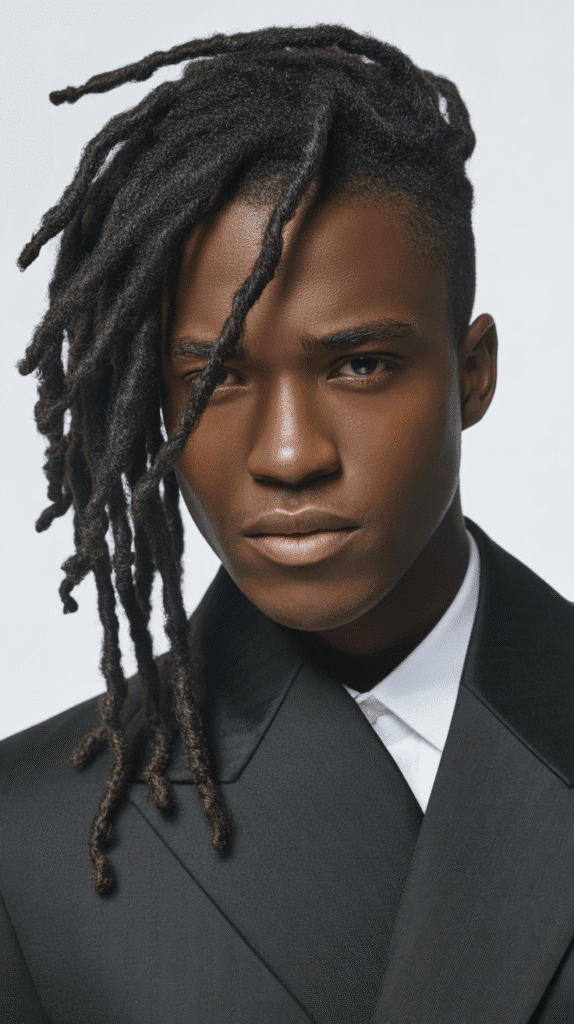
Side-swept dreads involve styling all locks dramatically to one side of the head, creating an asymmetrical, fashion-forward appearance.
This style adds immediate sophistication and editorial flair to any dreadlock length.
- All dreads are directed and styled toward one side, typically the left or right
- Works particularly well with undercuts or faded sides for enhanced contrast
- The asymmetry creates visual interest and frames the face differently
- Gel, pomade, or beeswax can help hold the sweep in place
- This style showcases the profile and works beautifully for photographs
- The non-swept side can be shaved, faded, or simply tucked behind the ear
- Popular in fashion, music, and entertainment industries
- Easily transitions to other styles by simply repositioning the dreads
16. Dread Top Knot
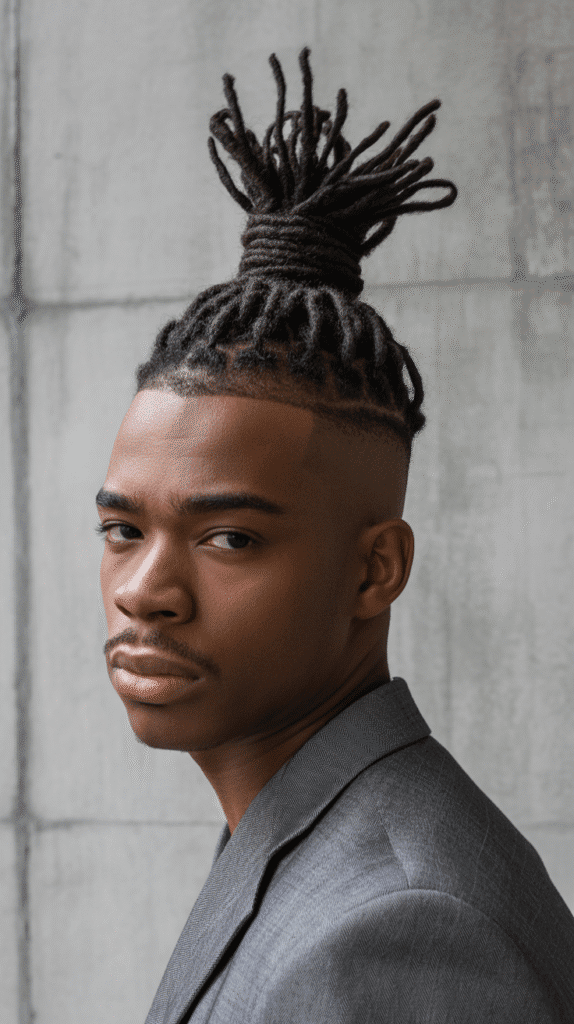
The dread top knot positions all dreadlocks in a high bun at the crown of the head, creating a distinctive silhouette that’s both practical and stylish.
This elevated style has become iconic in modern men’s grooming.
- All dreads are gathered and secured at the highest point of the head
- Creates maximum height and vertical emphasis
- The positioning keeps dreads completely off the neck and face
- Ideal for hot weather, physical activity, or professional environments
- The top knot can be tight and sleek or loose and textured
- Works best with medium to long dreadlocks for adequate gathering
- This style flatters angular face shapes and adds height to shorter men
- Undercuts or faded sides enhance the impact of the top knot
17. Triangle-Parted Dreads
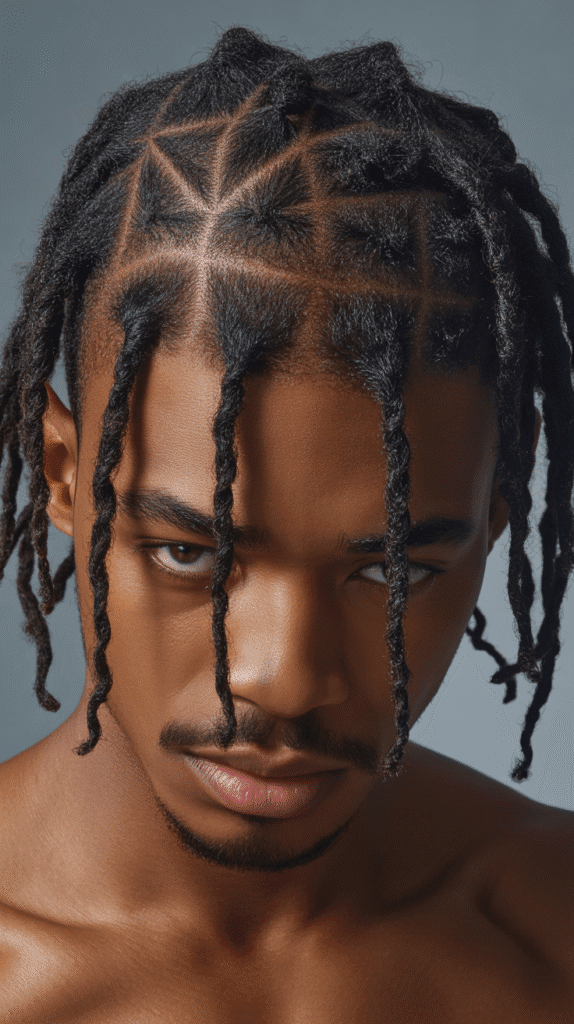
Triangle-parted dreads use triangular sections rather than traditional square or rectangular patterns, creating a distinctive geometric appearance with unique scalp visibility.
This systematic approach combines artistry with structure.
- The scalp is sectioned using triangular shapes before beginning the locking process
- Each triangle point can face different directions for varied visual effects
- This parting method allows dreads to sit more naturally against the scalp
- The geometric pattern is particularly visible during the early stages of locking
- Triangle sections distribute tension more evenly than square partings
- This technique is traditional in some African and Caribbean dreadlock methods
- The resulting dreads have more movement and dimensional positioning
- Best installed by experienced locticians familiar with geometric sectioning
18. Blonde Dreads
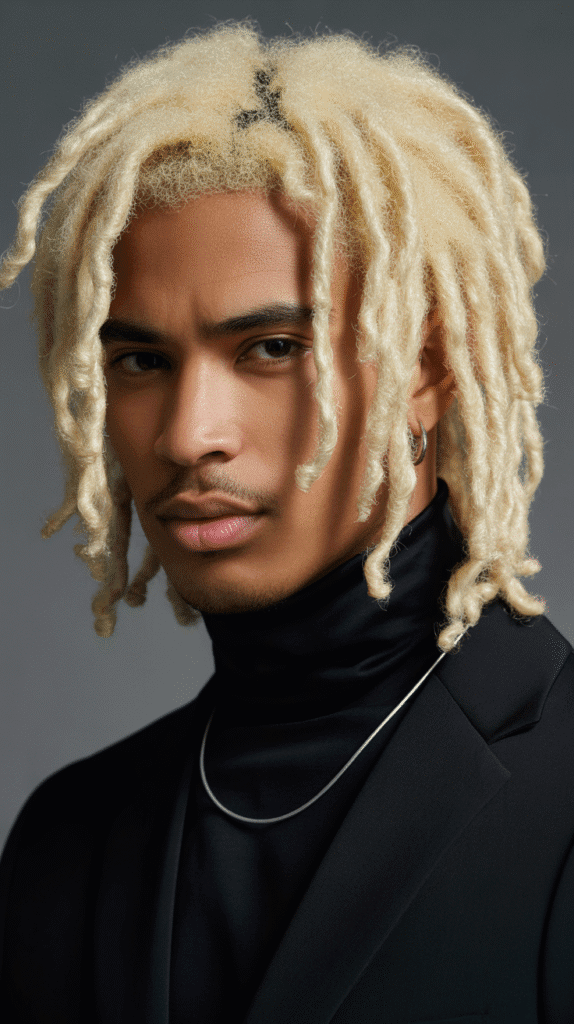
Blonde dreadlocks create a striking, attention-grabbing look that contrasts beautifully with darker skin tones and adds an edgy sophistication to any style.
This color transformation requires commitment and proper care.
- Achieving blonde requires significant bleaching, especially for naturally dark hair
- Multiple bleaching sessions may be necessary to reach desired lightness
- Professional colorists experienced with textured hair are essential
- Mature dreads handle bleaching better than new or budding locks
- Maintenance includes purple shampoo to prevent brassy yellow tones
- The contrast makes the texture and definition of dreads more visible
- Various blonde shades available: platinum, honey, golden, ash, or dirty blonde
- Requires extra moisturizing treatments to combat bleaching damage
19. Twisted Dreads with Design
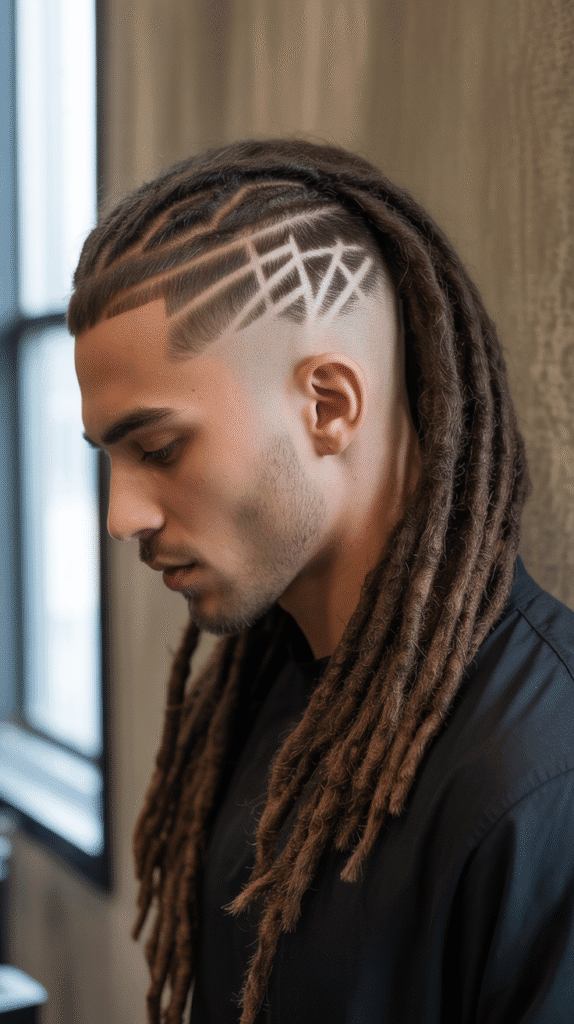
Twisted dreads with design incorporate shaved patterns or artistic designs into the shortened sides or back, adding personalized flair to the traditional dreadlock style.
This fusion creates a truly customized appearance.
- Designs are cut into faded or shaved sections around the dreadlocked areas
- Popular patterns include geometric lines, tribal designs, waves, or custom artwork
- The contrast between textured dreads and smooth designs creates visual drama
- Designs require touch-ups every 1-2 weeks as hair grows
- A skilled barber with design experience is essential for clean execution
- This style particularly resonates with younger men and creative professionals
- Designs can be changed regularly for fresh looks without altering the dreads
- Works best combined with undercuts, high top fades, or mohawk-style dreads
20. Dread with Taper Fade
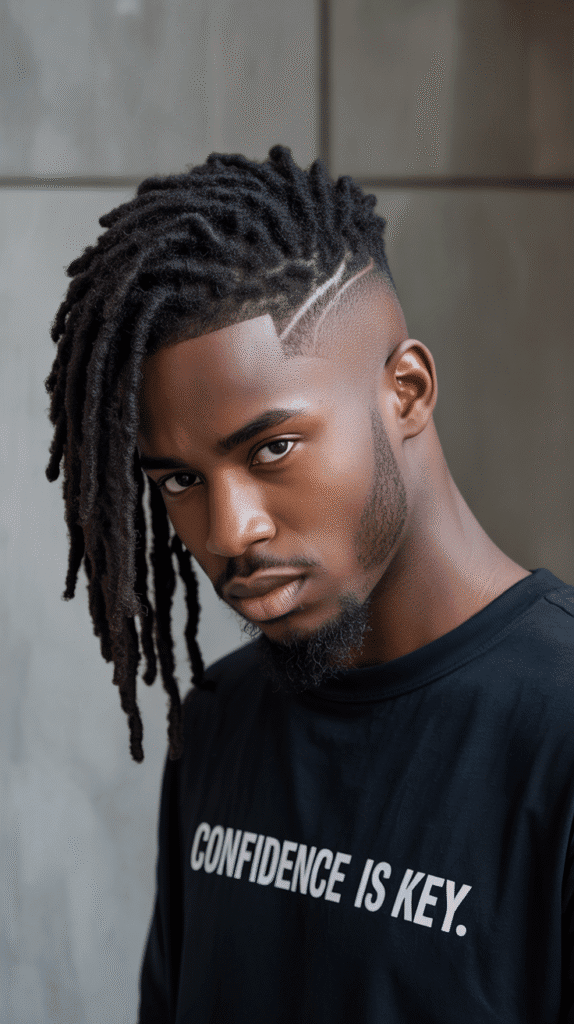
The taper fade with dreadlocks creates a gradual transition from longer dreads on top to cleanly faded sides and back.
This polished style bridges professional grooming with urban edge.
- The fade gradually shortens hair from the top down to skin level
- Taper fades can be low, mid, or high depending on where the fade begins
- Creates a softer, more blended appearance than hard undercuts
- The gradient effect draws attention upward to the dreadlocks
- Requires skilled barbering and regular maintenance every 2-3 weeks
- Works beautifully with all dread lengths and thicknesses
- The clean sides emphasize facial features and overall head shape
- One of the most popular professional dreadlock styles currently
21. Dreadlock Frohawk
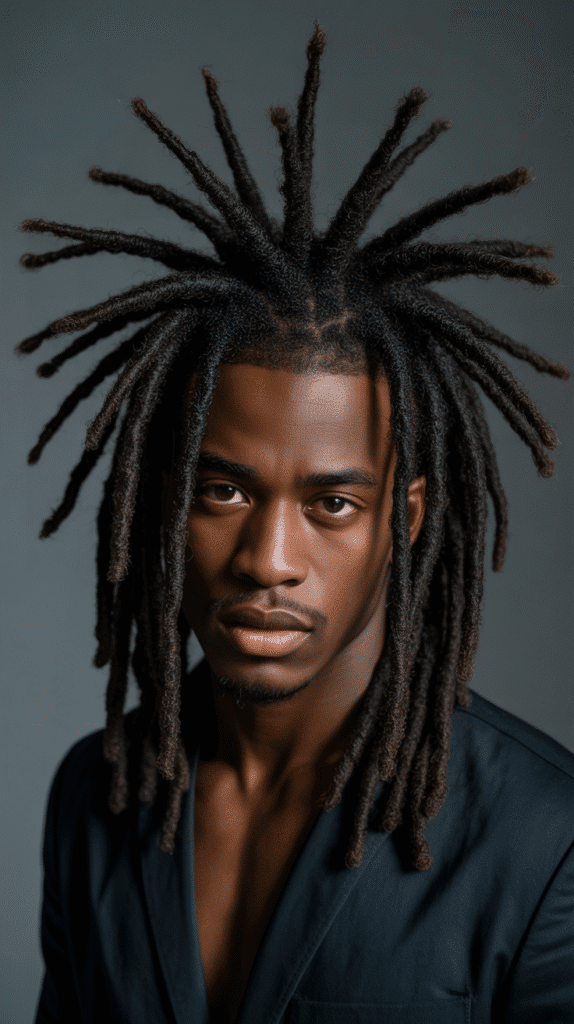
The dreadlock frohawk (fro-hawk) features dreads styled upward in a mohawk formation without shaving the sides completely.
This style offers the drama of a mohawk with more versatility and less commitment.
- Dreads are styled upward along the center of the head using gel or pomade
- Side dreads are twisted, pinned down, or styled flat against the head
- Creates the mohawk silhouette while maintaining hair on the sides
- This style can be undone and restyled differently when desired
- Works with various dread lengths, though medium length is ideal
- The frohawk appears bold and edgy while remaining reversible
- Popular for special occasions, performances, or creative photoshoots
- Provides dramatic height and visual impact without permanent commitment
22. Burgundy Dreads
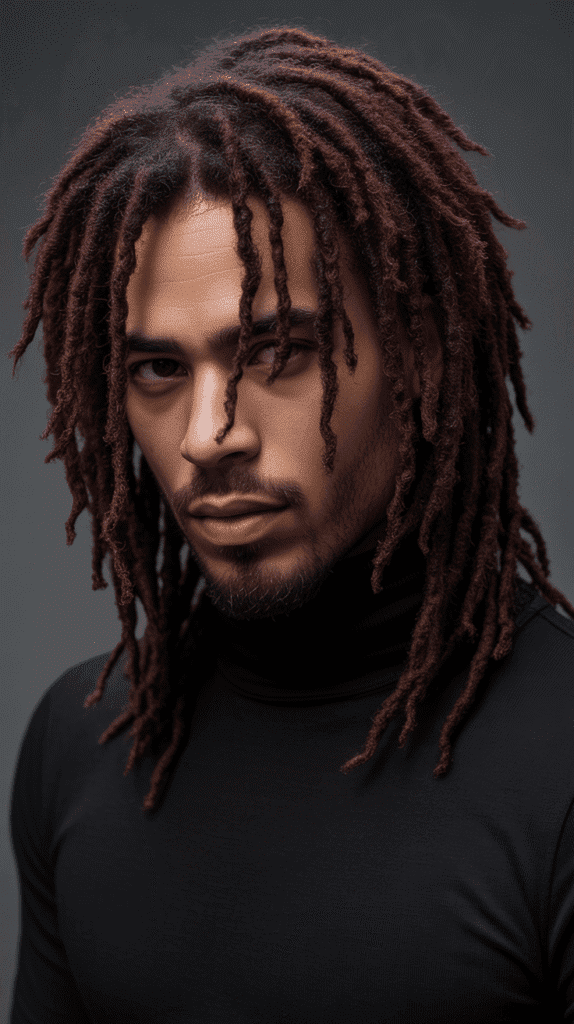
Burgundy dreadlocks offer a rich, sophisticated color option that’s bold yet more understated than brighter hues.
This deep red-wine shade adds warmth and dimension to locked hair.
- The color ranges from deep wine red to richer purple-tinged burgundy
- Works particularly well on medium to dark skin tones
- Requires less maintenance than lighter colors since regrowth is less noticeable
- Professional coloring ensures even distribution throughout the dreads
- The color adds depth and highlights the texture of mature locks
- Semi-permanent options cause less damage than permanent dyes
- Burgundy coordinates well with various wardrobe colors and styles
- The sophisticated shade works in both professional and creative environments
23. Gray/Silver Dreads
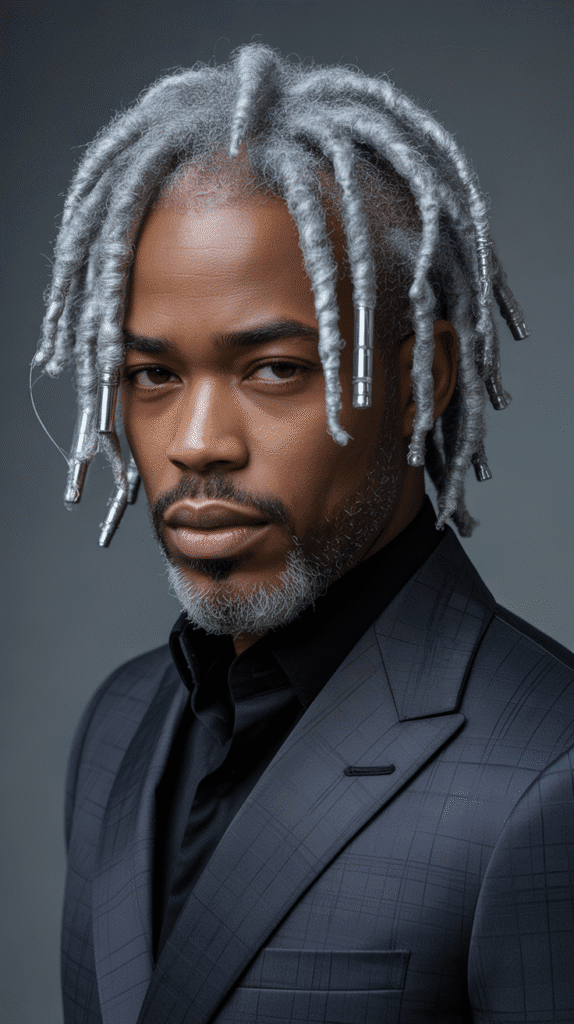
Gray or silver dreadlocks create a distinguished, fashion-forward appearance that’s gained popularity among men of all ages.
This striking color makes a powerful statement while maintaining sophistication.
- Achieving true silver requires lifting hair to very pale blonde first
- Silver toner is applied to create the metallic gray appearance
- The color showcases the texture and structure of dreads beautifully
- Maintenance includes purple shampoo to maintain cool tones and prevent yellowing
- Natural gray dreads on older men create a distinguished, wise appearance
- Intentionally dyed gray on younger men creates an edgy fashion statement
- The color reflects light differently, creating dimensional effects
- Works exceptionally well with darker skin tones for dramatic contrast
24. Red Dreads
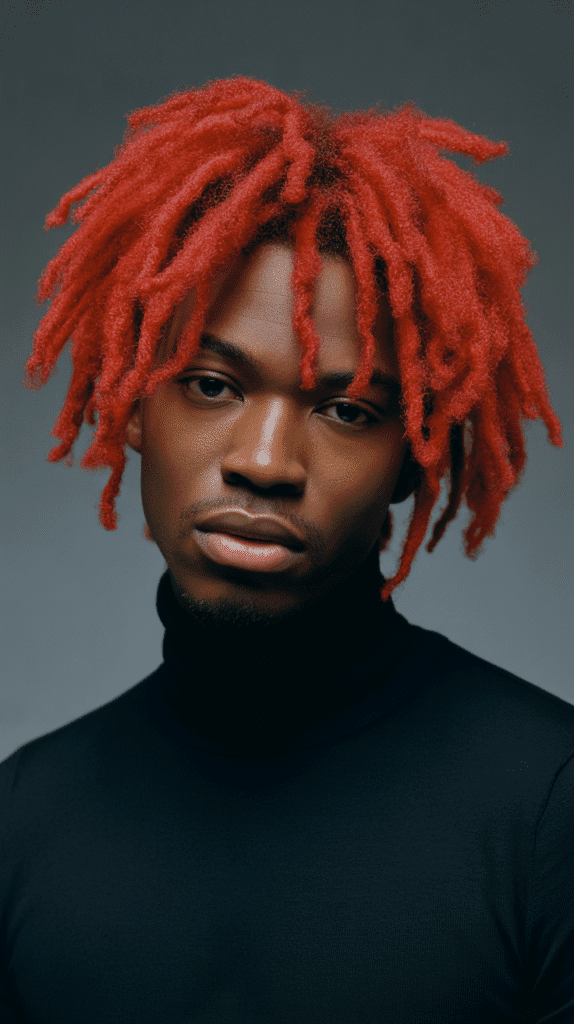
Red dreadlocks range from bright fire-engine red to deeper crimson shades, creating an attention-commanding look that’s impossible to ignore.
This vibrant color choice makes a bold personal statement.
- True bright red requires pre-bleaching on dark hair for color vibrancy
- Various red shades available: cherry, fire red, auburn, crimson, or copper
- Red pigment tends to fade faster than other colors, requiring more frequent touch-ups
- Color-depositing shampoos help maintain vibrancy between dyeing sessions
- The dramatic color particularly suits confident, extroverted personalities
- Works well in creative industries where self-expression is valued
- Consider skin undertones when selecting the specific red shade
- The color creates maximum contrast and visual impact
25. Blue Dreads
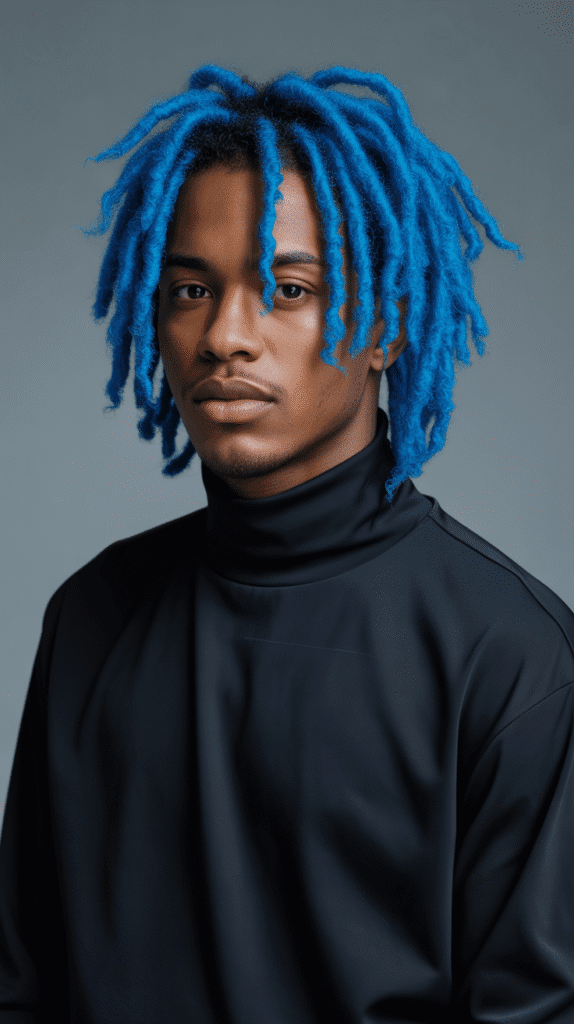
Blue dreadlocks offer a cool, contemporary aesthetic that ranges from subtle navy to electric cobalt.
This unconventional color choice appeals to men seeking unique, artistic expression.
- Color options include navy, royal blue, teal, cobalt, or pastel blue
- Darker blues work better for professional environments
- Lighter blues require more frequent maintenance and toning
- Blue pigment can stain temporarily but fades to interesting tones
- The color creates striking contrast, especially against darker skin
- Works particularly well in artistic, tech, and entertainment industries
- Can be combined with other colors for multi-tone effects
- Pre-lightening is necessary for vibrant blue shades
26. Ombre Dreads
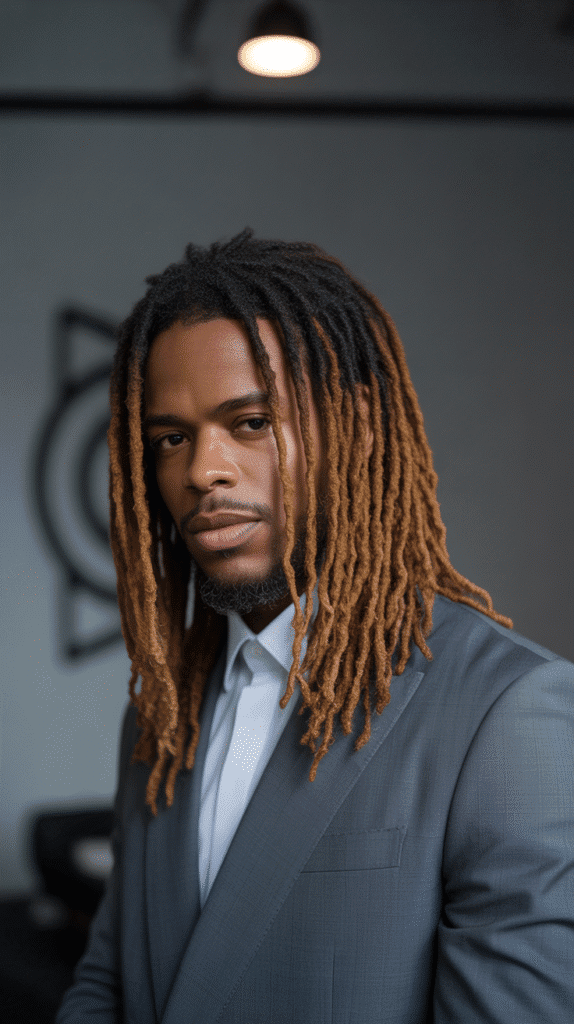
Ombre dreads feature a gradual color transition from darker roots to lighter ends, creating a dimensional, sun-kissed effect.
This coloring technique adds depth and visual interest without requiring full head bleaching.
- Color gradually transitions along the length of each dread
- Common combinations include black to brown, brown to blonde, or dark to vibrant colors
- The natural root color means less frequent maintenance than all-over color
- Creates the illusion of naturally lightened ends from sun exposure
- Works beautifully on medium to long dreads where transition is visible
- Professional colorists can create smooth, seamless gradients
- The dimensional effect makes dreads appear more textured and dynamic
- Less damaging than full head bleaching since roots remain natural
27. Half-Up Dread Style
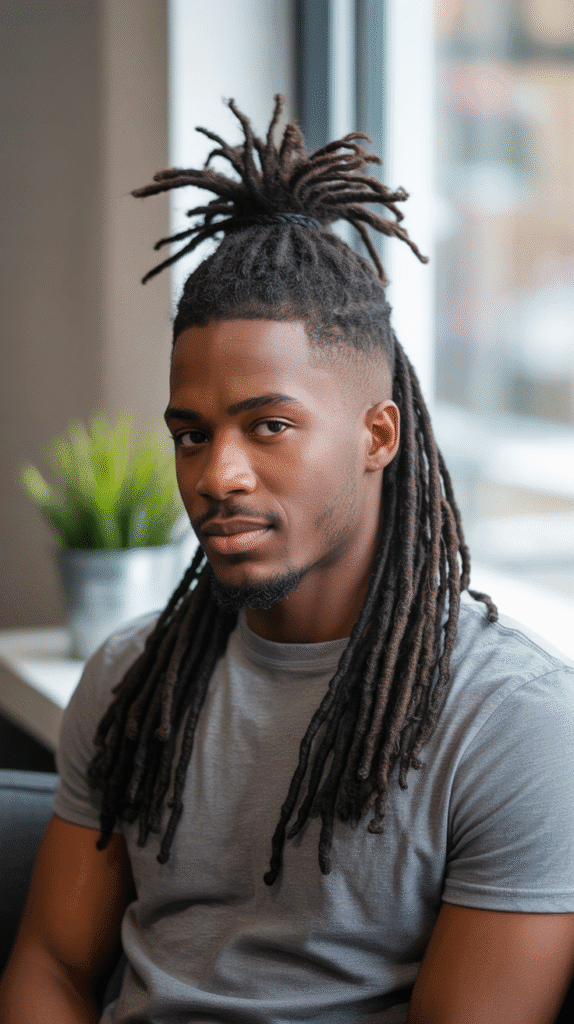
The half-up dread style involves gathering the top portion of dreadlocks while leaving the bottom half flowing freely.
This versatile look offers the best of both worlds—style and functionality.
- The top section (usually crown to temples) is pulled up and secured
- Bottom dreads flow freely, maintaining length visibility
- Creates face-framing effect while keeping hair partially controlled
- Works well for medium to long dreadlocks
- The style flatters most face shapes by adding height
- Practical for activities while maintaining a styled appearance
- Can be secured with elastic bands, wrapped dreads, or decorative accessories
- Easily adjustable throughout the day for different looks
28. Dread Pigtails
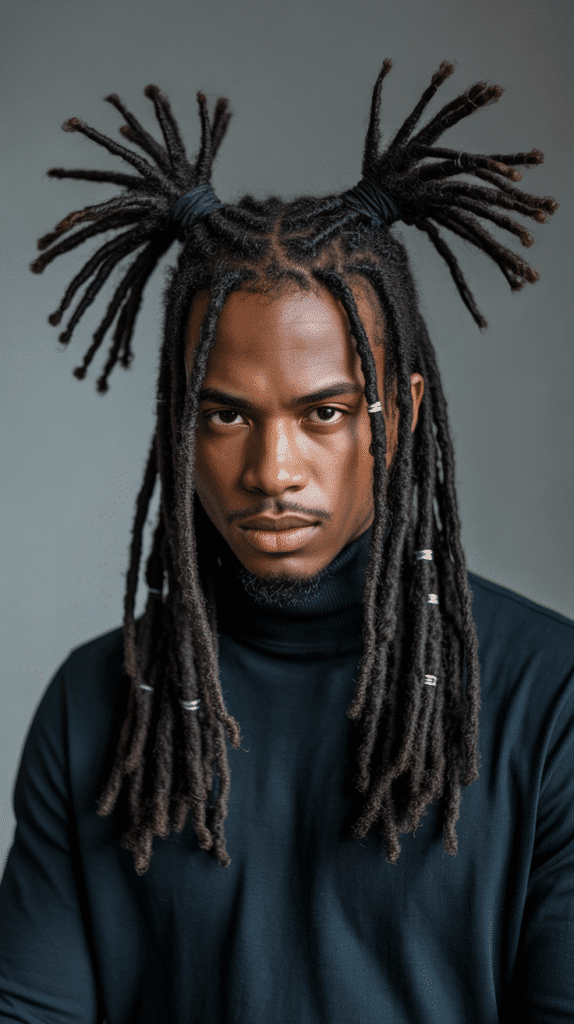
Dread pigtails separate longer dreadlocks into two symmetrical ponytails on either side of the head.
While unconventional for men, this bold style makes a distinctive fashion statement.
- Dreads are parted down the center and secured on each side
- Positioning can vary from high (above ears) to low (at neck level)
- Creates a youthful, rebellious, or avant-garde appearance
- Works best with medium to long dreadlocks for adequate length
- The symmetry creates visual balance and frames the face
- Popular in alternative fashion and music subcultures
- Can be styled loose or braided for additional texture
- Challenges traditional masculine hairstyle conventions
29. Messy Dread Bun
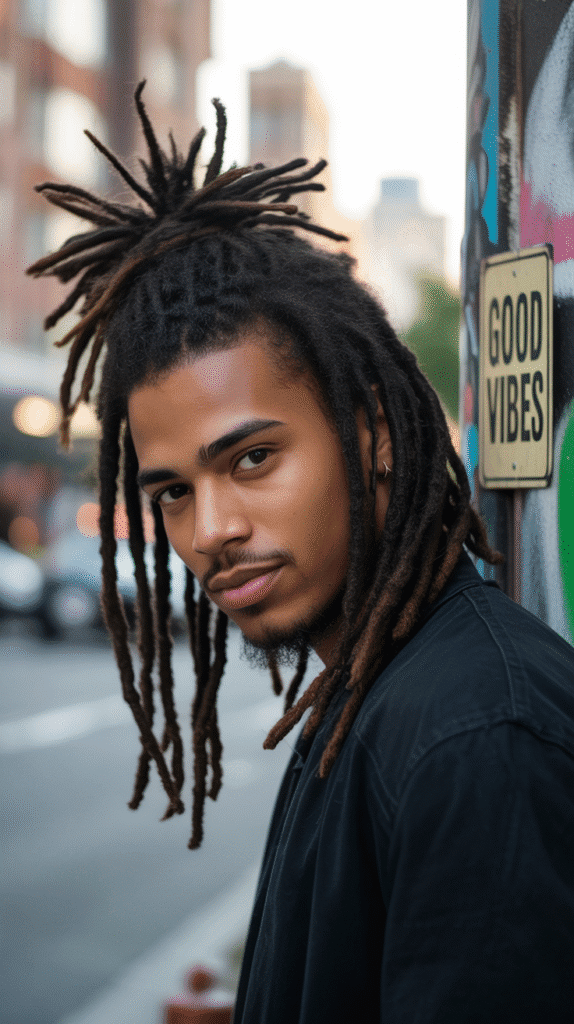
The messy dread bun embraces intentional imperfection, creating a relaxed, effortlessly cool appearance.
This casual style works for medium to long dreads and suits laid-back personalities.
- Dreads are loosely gathered without precise positioning or smoothing
- Some locks intentionally escape or frame the face
- Creates a more textured, voluminous appearance than neat buns
- The relaxed aesthetic works for casual and creative environments
- Requires minimal time and styling products
- The imperfection adds character and personality to the look
- Works well for weekend wear or casual social settings
- Can be positioned high, mid, or low depending on preference
30. Sisterlocks for Men
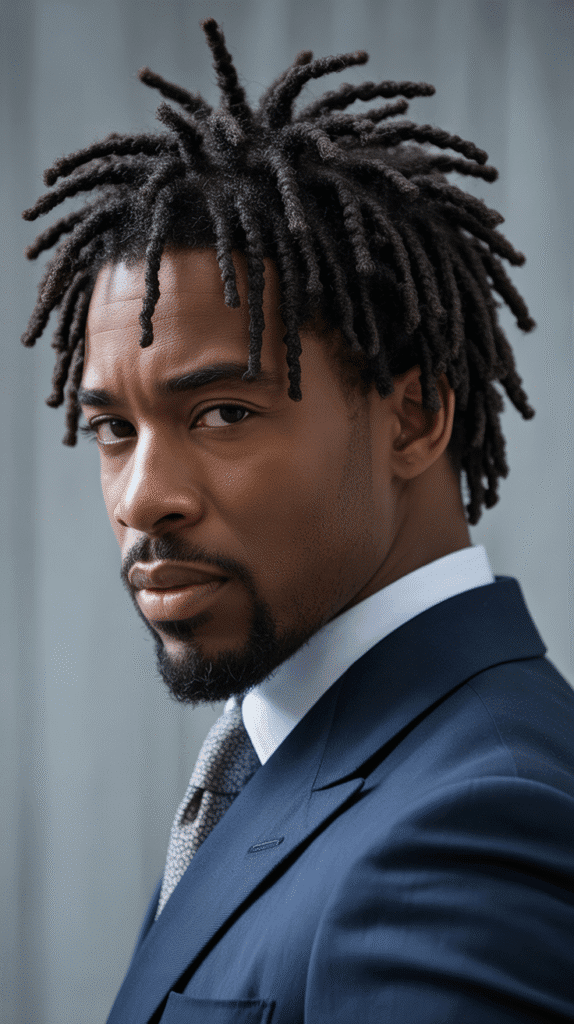
Sisterlocks represent an extremely refined locking technique featuring very small, uniform locks created through a specific interlocking method.
While traditionally associated with women, men increasingly embrace this precise style.
- Individual locks are significantly smaller than traditional dreads
- Installation requires certified Sisterlocks consultants
- The technique uses a specialized tool for precise interlocking
- Creates hundreds of tiny, uniform locks across the scalp
- Offers maximum styling versatility due to the small lock size
- Maintenance requires professional retightening every 4-8 weeks
- The refined appearance works exceptionally well in professional settings
- Growing process is lengthy but results in elegant, manageable locks
31. Freeform with Undercut
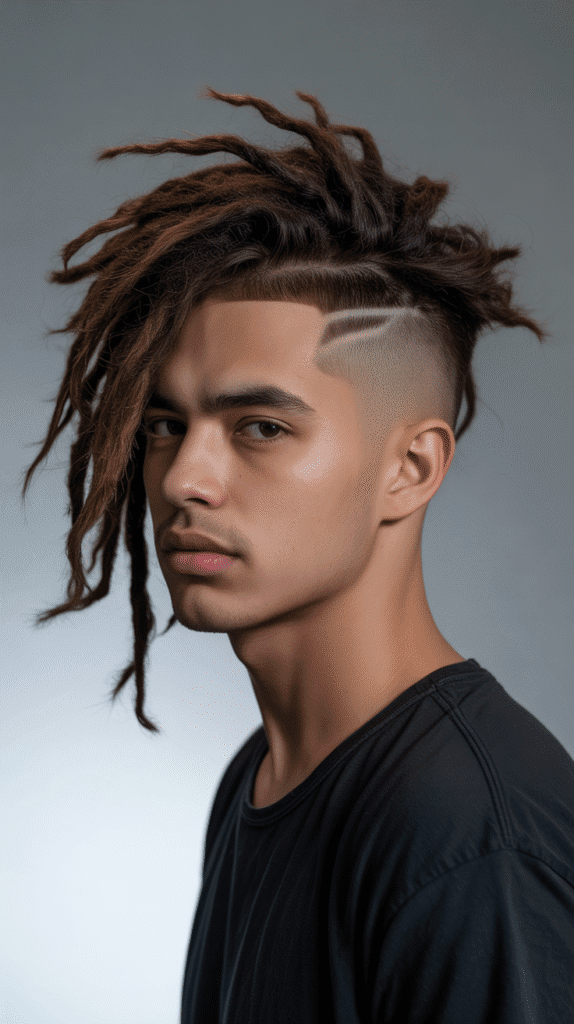
Freeform dreads with undercut combine organic lock formation with modern barbering, creating an interesting fusion of natural and styled elements.
This hybrid approach appeals to men wanting both authenticity and contemporary edge.
- The top dreads develop naturally without manipulation
- Sides and back are regularly cut or faded for clean contrast
- Creates balance between wild organic texture and refined grooming
- The undercut prevents excessive bulk while maintaining the freeform aesthetic
- Regular barber visits maintain the cut while dreads develop freely
- This style works well for professional creative environments
- The contrast emphasizes the natural beauty of freeform locks
- Combines philosophical dreadlock approach with practical modern styling
32. Dread Wrapped with Thread
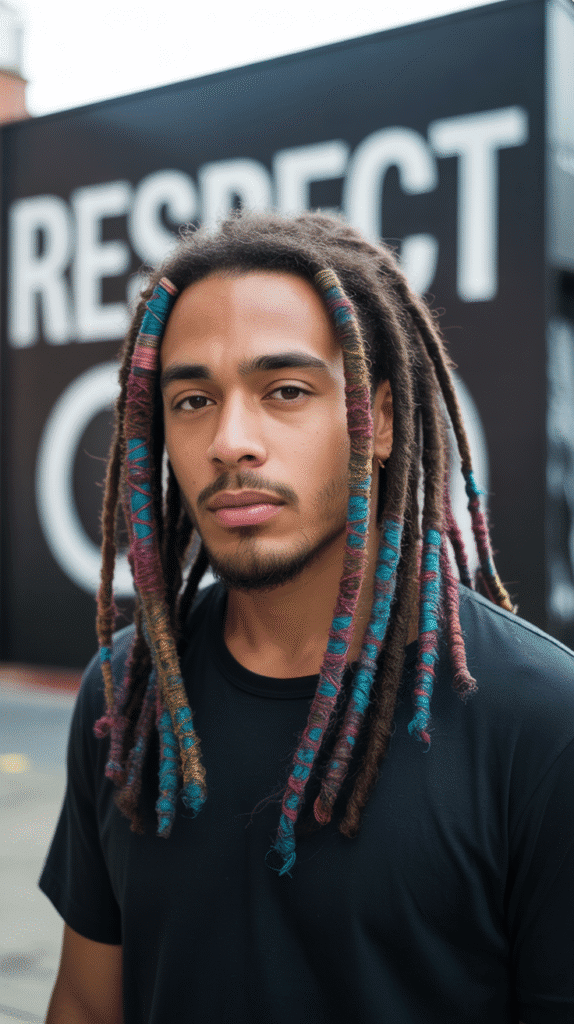
Thread-wrapped dreadlocks incorporate colored threads, yarn, or string wrapped around sections of locks, adding colorful accents and personal flair.
This decorative technique has cultural significance while offering modern customization.
- Embroidery thread, yarn, or special wrapping cord is wound tightly around dreads
- Can wrap entire locks or just sections for accent effects
- Colors can match, contrast, or create patterns along the length
- The wrapping adds protection and can help loose ends lock
- Removal is simple by cutting and unwrapping the thread
- Traditional in many African and Rastafarian dreadlock customs
- Creates visual interest without permanent color changes
- Allows frequent style changes through different color selections
33. Crown Braid Dreads
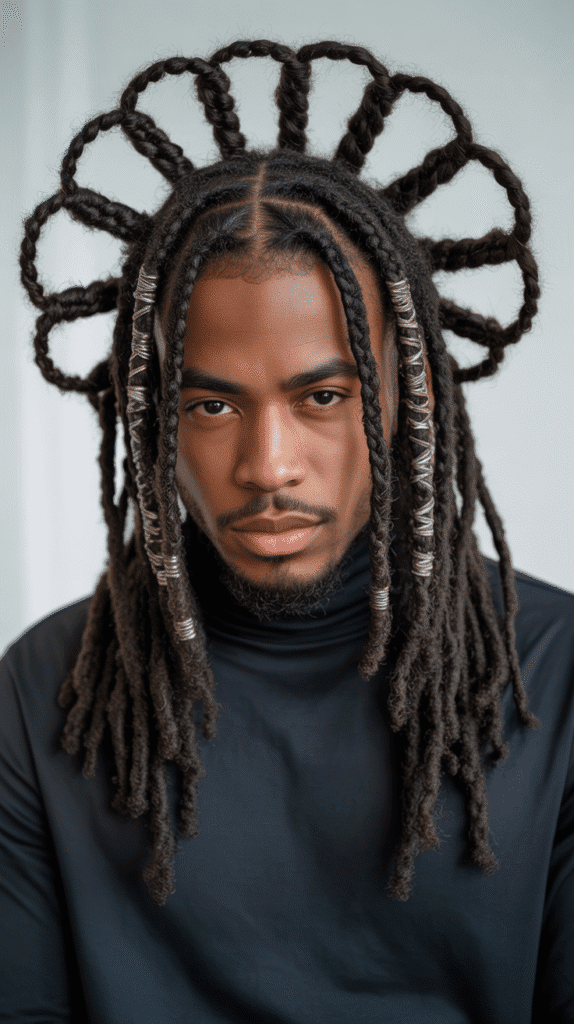
Crown braid dreads involve braiding dreadlocks in a circular pattern around the head, creating a regal, halo-like appearance.
This sophisticated style showcases the length and versatility of mature locks.
- Dreads are braided along the perimeter of the head in a circular formation
- Creates a crown or halo effect that sits atop the head
- Works best with medium to long dreads for adequate braiding length
- The style keeps all hair secured and off the face and neck
- Requires some practice or professional assistance to execute properly
- Creates an elegant, refined appearance suitable for formal occasions
- The circular braid can incorporate all dreads or leave some flowing
- Cultural significance in various African braiding traditions
Maintenance Tips for Modern Dreadlocks
Proper maintenance ensures your dreadlocks remain healthy, attractive, and well-formed regardless of the style you choose. Understanding fundamental care practices makes the difference between stunning locks and problematic hair.
- Wash dreadlocks regularly with residue-free, clarifying shampoo every 1-2 weeks
- Avoid heavy oils and products that cause buildup inside the locks
- Dry dreads thoroughly after washing to prevent mildew and odor
- Retwist or maintain roots every 4-8 weeks depending on your locking method
- Sleep with a silk or satin bonnet or pillowcase to reduce friction
- Separate dreads regularly to prevent unwanted combining or congos
- Palm roll locks occasionally to maintain cylindrical shape
- Avoid excessive manipulation which can cause thinning and breakage
- Stay hydrated and maintain good nutrition for healthy hair growth
- Schedule regular professional maintenance for complex styles
Dreadlock Products and Tools Essential for Men
Maintaining modern dreadlocks requires specific products designed for locked hair. Using the right tools prevents damage and supports healthy lock development.
- Residue-free shampoo: Prevents buildup inside locks that causes odor and prevents tightening
- Locking gel or wax: Provides hold during retwisting without heavy residue
- Aloe vera juice: Natural moisturizer that doesn’t leave buildup
- Rose water spray: Refreshes dreads between washes and adds light moisture
- Dreadlock sponge: Creates uniform coils for starter dreads
- Metal rat-tail comb: Precision sectioning during initial locking
- Interlocking tool: Maintains roots using the interlocking method
- Silk or satin bonnet: Protects dreads during sleep
- Edge control: Tames flyaways and maintains neat edges
- Natural oils (jojoba, grapeseed): Light oils for scalp health without heavy buildup
- Baking soda and apple cider vinegar: Natural deep cleansing treatments
- Hair elastics designed for locs: Prevents breakage and slippage
Common Dreadlock Mistakes to Avoid
Understanding what not to do is equally important as knowing proper maintenance techniques. These common mistakes can compromise your dreadlock health and appearance.
- Over-twisting: Causes thinning at the roots and potential breakage
- Using regular shampoos: Leaves residue that prevents proper locking
- Insufficient drying: Creates mildew, odor, and potential mold issues
- Starting with too-short hair: Hair should be at least 4-6 inches for most methods
- Neglecting scalp health: Leads to itching, flaking, and poor hair growth
- Using petroleum-based products: Creates stubborn buildup that’s difficult to remove
- Skipping separation: Allows dreads to combine and create unwanted congos
- Excessive coloring: Weakens locks and can cause breakage
- Tight styling: Causes traction alopecia and permanent hair loss
- Rushing the locking process: Results in weak, loose locks that don’t mature properly
- Infrequent washing: Contradicts the myth that dreads shouldn’t be washed
- Using wax on new dreads: Prevents proper locking and attracts dirt
How Long Does It Take to Grow Dreadlocks?
The timeline for dreadlock development varies significantly based on hair type, chosen method, and desired length. Understanding these timeframes helps set realistic expectations.
Initial Locking Phase (Weeks 1-12):
- Hair begins to coil and form budding locks
- Appearance may seem messy or unrefined
- Sections are visible but not fully locked
- Regular maintenance establishes the foundation
Teenage Phase (Months 3-12):
- Locks begin to tighten and mature
- Frizz and flyaways are common
- Length appears to shrink as locks tighten
- Patience is critical during this awkward phase
Mature Phase (Year 1+):
- Locks are fully formed and solid throughout
- The tightening process is largely complete
- Growth becomes more noticeable
- Maintenance becomes more routine
Length Milestones:
- Shoulder-length: 2-3 years from scalp
- Mid-back length: 4-5 years from scalp
- Waist-length: 6-8 years from scalp
- Growth rate averages 4-6 inches per year but appears slower due to shrinkage
Dreadlocks in Professional Settings
Modern workplaces increasingly accept dreadlocks, though maintaining a professional appearance remains important. These strategies help navigate professional environments successfully.
- Choose neat, well-maintained styles over intentionally messy looks
- Keep dreads clean, odor-free, and visibly groomed
- Conservative lengths and colors work best in traditional corporate environments
- Styling dreads back in buns or ponytails creates polished appearances
- Industries like tech, creative, and entertainment typically offer more flexibility
- Know your company culture and dress code policies
- Lead with competence and professionalism rather than hairstyle
- Educational and healthcare settings may have specific requirements
- Government positions increasingly protect natural hair rights
- Discrimination based on natural hairstyles is illegal in many jurisdictions
- Consider the CROWN Act protecting natural hair in workplaces
- Schedule maintenance appointments to consistently look groomed
Cultural Significance and Respect
Dreadlocks carry deep cultural and spiritual significance across various communities. Understanding this history promotes respectful wearing and appreciation.
- Rastafarian tradition: Represents covenant with God and rejection of Babylon system
- African history: Ancient Egyptian, Ethiopian, and various tribal traditions
- Hindu and Buddhist practices: Sadhus and spiritual ascetics wear locked hair
- Nazarite vows: Biblical references to uncut hair as spiritual commitment
- Celtic and Viking history: Historical evidence of locked hair in European cultures
- Modern adoption: Transcends specific cultures while respecting origins
- Educate yourself on the historical and spiritual significance
- Acknowledge the cultural roots when discussing your dreadlocks
- Recognize that some communities have faced discrimination for this hairstyle
- Wear your locks with respect and understanding of their deeper meaning
- Support policies protecting natural hairstyles from discrimination
- Appreciate rather than appropriate cultural elements
Transitioning from Relaxed or Chemically Treated Hair
Men transitioning from chemically treated hair to dreadlocks face unique challenges. Proper transition planning ensures healthy lock development.
- Allow new growth: Wait for 2-4 inches of natural, untreated hair
- Big chop option: Cut off all chemically treated hair and start fresh
- Gradual transition: Lock natural hair as it grows while trimming treated ends
- Strengthen hair: Use protein treatments to repair chemically damaged sections
- Deep condition regularly: Restore moisture lost through chemical processing
- Avoid overlapping treatments: Never apply chemicals to already locked sections
- Consult professionals: Locticians experienced with transitioning hair provide best results
- Patience is essential: Transitioning can take 6-12 months or longer
- Protect during transition: Minimize heat and manipulation stress
- Monitor breakage: Treated hair is more fragile during the transition period
- Two-strand twists work well for transitioning hair
- Consider hair health before committing to the dreadlock process
Dreadlock Removal and Reversibility
While dreadlocks are considered permanent, they can be removed through patient combing. Understanding this process helps make informed decisions.
- Mature locks are difficult but possible to remove: Expect significant time investment
- Soaking in conditioner: Softens locks and loosens internal knots
- Patient combing: Work from ends toward roots with a metal comb
- Hair loss is expected: Some breakage and shedding occurs during removal
- Professional removal services: Specialized services assist with the process
- Time requirement: Can take 6-40+ hours depending on length and maturity
- Earlier removal is easier: Locks under 1 year are simpler to comb out
- Alternative option: Cut dreads off and start fresh with natural hair
- Hair may appear shorter: Years of shrinkage mean released hair shows less length
- Condition intensively: Restored hair needs moisture and protein treatments
- Temporary alternatives: Faux locs or extensions offer non-permanent options
- Consider removal difficulty before starting permanent locks
Seasonal Dreadlock Care Adjustments
Different seasons require adjusted care routines to maintain healthy dreadlocks throughout the year. Weather impacts locked hair differently than loose hair.
Summer Care:
- Increase washing frequency due to sweat and increased activity
- Protect from chlorine and salt water with pre-swim wetting and post-swim rinsing
- Use lightweight moisturizers that won’t feel heavy in heat
- Dry thoroughly to prevent moisture buildup in humidity
- Consider protective styles that keep locks off the neck
- Sun exposure can naturally lighten dreads over time
- Increase hydration to support healthy hair growth
Winter Care:
- Reduce washing frequency as scalp produces less oil
- Combat dryness with regular moisturizing sprays
- Protect from harsh winds with hats or bonnets
- Indoor heating causes additional dryness requiring extra moisture
- Static can be controlled with anti-static sprays or oils
- Thorough drying is crucial in cold weather to prevent freezing
- Layer protection with silk under winter hats
Transitional Seasons:
- Adjust routines gradually as weather changes
- Monitor scalp response to temperature fluctuations
- Prepare for increased shedding during seasonal changes
- Balance moisture levels as humidity varies
Dreadlocks and Physical Activity
Active lifestyles and sports are fully compatible with dreadlocks when proper precautions are taken. These strategies keep locks secure and healthy during physical activities.
- Secure styling: Use buns, ponytails, or braids during intense activities
- Sweatbands and headbands: Absorb moisture and keep locks away from face
- Post-workout washing: Rinse or wash after heavy sweating sessions
- Swimming protection: Wet dreads with fresh water before entering chlorinated pools
- Helmet compatibility: Shorter or bundled styles work better under protective gear
- Martial arts: Tight buns prevent grabbing and interference
- Running and cardio: Secured styles prevent bouncing and discomfort
- Weightlifting: Keep dreads away from equipment and prevent snagging
- Yoga and flexibility: Ensure locks don’t obstruct vision or movement
- Team sports: Check regulations about hair length and securing requirements
- Dry thoroughly after aquatic activities
- Retwist or maintain after periods of intense physical activity
Styling Dreadlocks for Special Occasions
Special events call for elevated dreadlock styling that showcases your locks while fitting the occasion. These formal and semi-formal options add sophistication.
Formal Events (Weddings, Galas, Ceremonies):
- Crown braids or circular braid patterns create elegant, refined appearances
- Low buns with wrapped accents offer classic sophistication
- Decorative beads, cuffs, or metallic accessories add formal flair
- Slicked-back styles with clean edges provide polished looks
- Consider temporary color sprays for added drama
Semi-Formal Occasions (Dinner Parties, Dates, Professional Events):
- Half-up styles balance formal and casual aesthetics
- Side-swept arrangements create romantic, stylish appearances
- Neat ponytails or buns maintain professional polish
- Well-maintained loose dreads work when properly groomed
- Subtle accessories like leather or wooden beads add interest
Casual Special Events (Parties, Concerts, Social Gatherings):
- Creative braiding patterns showcase personality
- Colorful wraps or temporary decorations add festive elements
- Messy buns embrace relaxed sophistication
- Multiple ponytails or pigtails create playful aesthetics
- Experiment with new styles and accessories
Budget Considerations for Dreadlock Maintenance
Understanding the financial commitment helps plan for sustainable dreadlock care. Costs vary based on style choice, maintenance method, and whether you self-maintain or visit professionals.
Initial Installation Costs:
- Professional installation: $200-$800+ depending on method and length
- DIY installation: $20-$100 for products and tools
- Consultation fees: $0-$50 at specialized salons
Ongoing Maintenance:
- Professional retwisting: $50-$150 every 4-8 weeks
- Self-maintenance products: $10-$30 monthly
- Specialized shampoos and treatments: $15-$40 per bottle (lasts 1-3 months)
Additional Services:
- Professional coloring: $150-$400+ per session
- Loc repair (broken or damaged locks): $50-$200
- Deep cleaning treatments: $75-$150
- Styling for special occasions: $30-$100
Cost-Saving Strategies:
- Learn self-maintenance techniques through tutorials and practice
- Purchase products in bulk for better pricing
- Mix your own maintenance sprays using natural ingredients
- Trade services with other loc-wearing friends
- Invest in quality tools that last for years
- Schedule professional services only when necessary
Conclusion
33 Latest Dreadlock Styles for Men That Are Bold and Modern represents far more than a collection of hairstyles—it’s a comprehensive journey through one of the most expressive and versatile hair choices available to contemporary men.
From the clean sophistication of taper fades to the organic authenticity of freeform locks, from subtle professional styles to vibrant colored statements, the dreadlock world offers unlimited possibilities for self-expression.
The key to successful dreadlocks lies in understanding your hair type, committing to proper maintenance, choosing styles that complement your lifestyle and face shape, and wearing your locks with confidence and respect for their cultural significance.
Whether you’re just beginning your loc journey or seeking fresh inspiration for mature dreads, these 33 styles demonstrate that dreadlocks continue to evolve, breaking boundaries while honoring tradition.
Your hair is your crown—wear it boldly, maintain it properly, and let your unique style reflect the authentic, modern man you are.
The right dreadlock style isn’t just about following trends; it’s about finding the perfect expression of your individuality, personality, and the bold statement you want to make in the world.